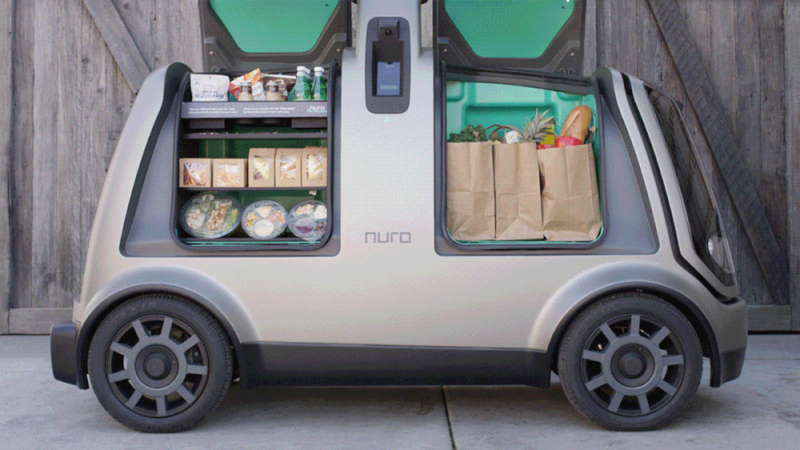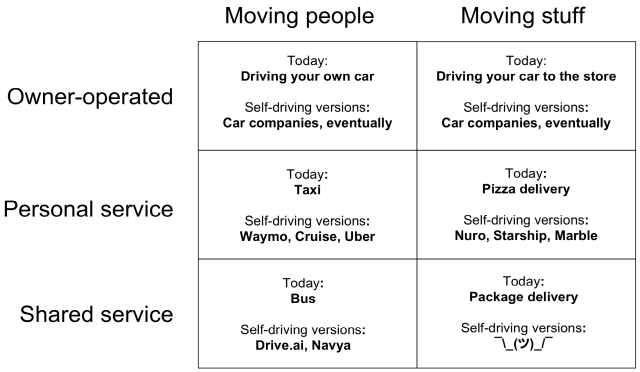
When people think about self-driving cars, they naturally think about, well, cars. They imagine a future where they buy a new car that has a "self drive" button that takes them wherever they want to go.
That will happen eventually. But the impact of self-driving technology is likely to be much broader than that. Our roads are full of trucks, taxis, buses, shuttles, delivery vans, and more—all of these vehicles will have self-driving equivalents within a decade or two.
The advent of self-driving technology will transform the design possibilities for all sorts of vehicles, giving rise to new vehicle categories that don't exist now and others that straddle the line between existing categories. It will also change the economics of transportation and delivery services, making on-demand delivery a much faster, cheaper, and more convenient option.
Recently we had the chance to talk to two self-driving vehicle startups that are at the forefront of these trends.
Earlier this month, the startup Drive.ai announced an autonomous shuttle service that will launch in July in the Dallas metropolitan area. The company's vehicles straddle the line between buses and taxis—like a bus, they're designed for shared service in a fixed area, but rather than being on a fixed route and schedule, they can be hailed on demand.
Meanwhile, Nuro is building self-driving cars for moving goods instead of people, and it recently applied for permission to test its fully driverless vehicles in Arizona. Because Nuro's cars don't need room for passengers—or all the safety equipment a human rider needs—Nuro's cars can be much smaller and lighter (and therefore cheaper and safer) than a conventional car.
You can think of this as a high-tech replacement for a pizza delivery guy, but Nuro co-founder Dave Ferguson argues that the potential market here is much bigger. Without the need to pay a driver, on-demand deliveries will become much cheaper, so a lot more stores will offer delivery services. Instead of running to the grocery store for a couple of ingredients, you'll be able to order them on your smartphone and have them show up at your door 30 minutes later.
Talking to these companies helped me appreciate how much both the design of vehicles and the economics of transportation services is driven by the need for human drivers. The roads of the future are going to have a richer assortment of vehicles of all sizes, shapes, and functions. Companies are only starting to explore what they might look like.
Self-driving technology will change the transportation landscape
To help myself think through the design space for self-driving vehicles, I created this two-dimensional grid showing some of the most common vehicles on the road today and the companies that are working on self-driving vehicles in the same categories:

In most parts of America, the market is currently dominated by the top row of the chart: owner-operated vehicles. Most people get around town by driving their own cars. To buy stuff, they drive their own cars to the store, then drive home with their purchases.
But other people rely on third-party services to move themselves and their purchases. Today someone who wants to get around without owning a car can choose between a taxi or a shared mode of transit like a bus (or a train in some areas). Taxis are faster and more convenient, but they're expensive enough that only wealthy people can afford to use them on a daily basis.
The story is similar when it comes to moving stuff around. You don't have to drive to a store to buy stuff. You can also have it delivered. And there are two basic options here. Most products are delivered using a service like UPS or FedEx, and it takes a day or two to get your stuff to you. But some companies, like pizza restaurants, offer personalized on-demand deliveries measured in minutes rather than days.
The tradeoff here is similar to the taxi-vs-bus tradeoff. On-demand services are faster and more convenient for customers, but they're so expensive that they tend to only be used in cases (like pizza delivery) where slower, cheaper options aren't practical.
The self-driving revolution is going to fundamentally change the economics of all of these markets.
We can expect the owner-operated segment of the market—for both transporting people and stuff—to shrink over time. Of course, some people will still want to drive themselves around and shop in brick-and-mortar stores. But labor costs account for more than half of the cost of a conventional taxi service. So as the cost of self-driving hardware inevitably falls with scale, we can expect self-driving taxis to cost dramatically less than a conventional taxi costs today.
That should increase demand for taxi rides—both from former bus riders, who can now afford a more convenient option, and from some former drivers who are happy to give up the hassles of car ownership.
And we should see a similar shift in the transportation of stuff. As on-demand delivery options get more affordable, some people who would previously have driven to the store will let stores send stuff to them instead. Others will shift from two-day shipping on Amazon to 30-minute shipping using an on-demand service.
reader comments
249